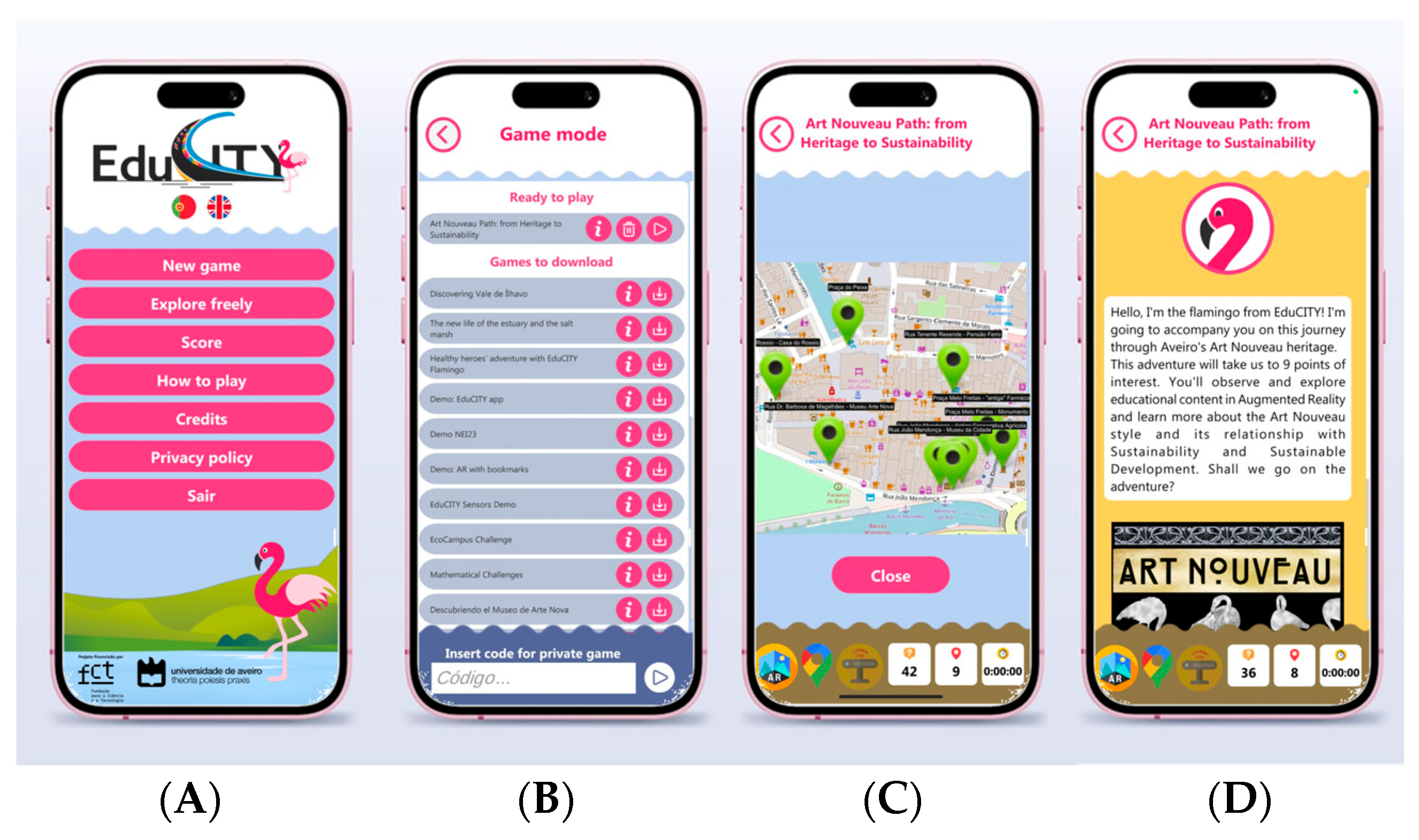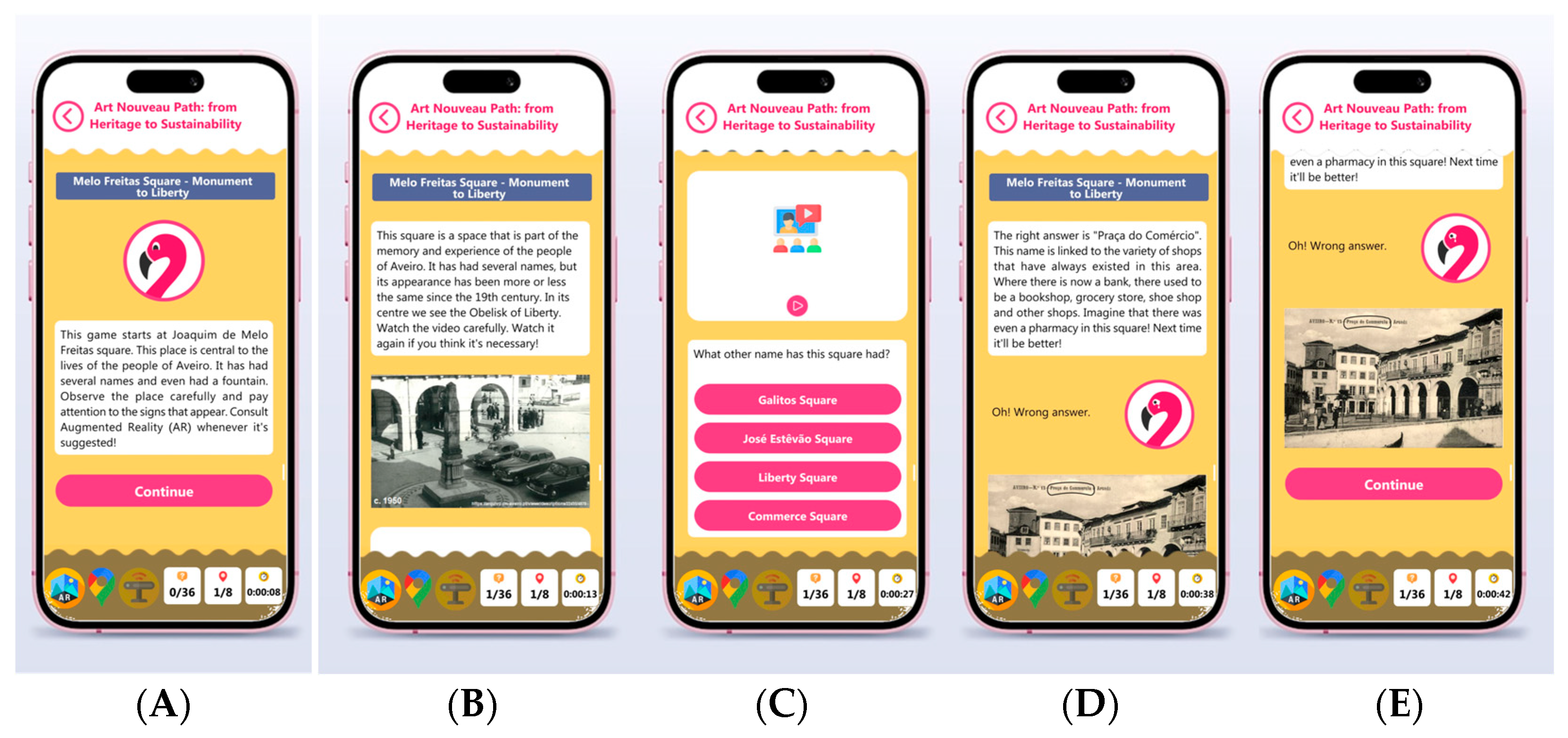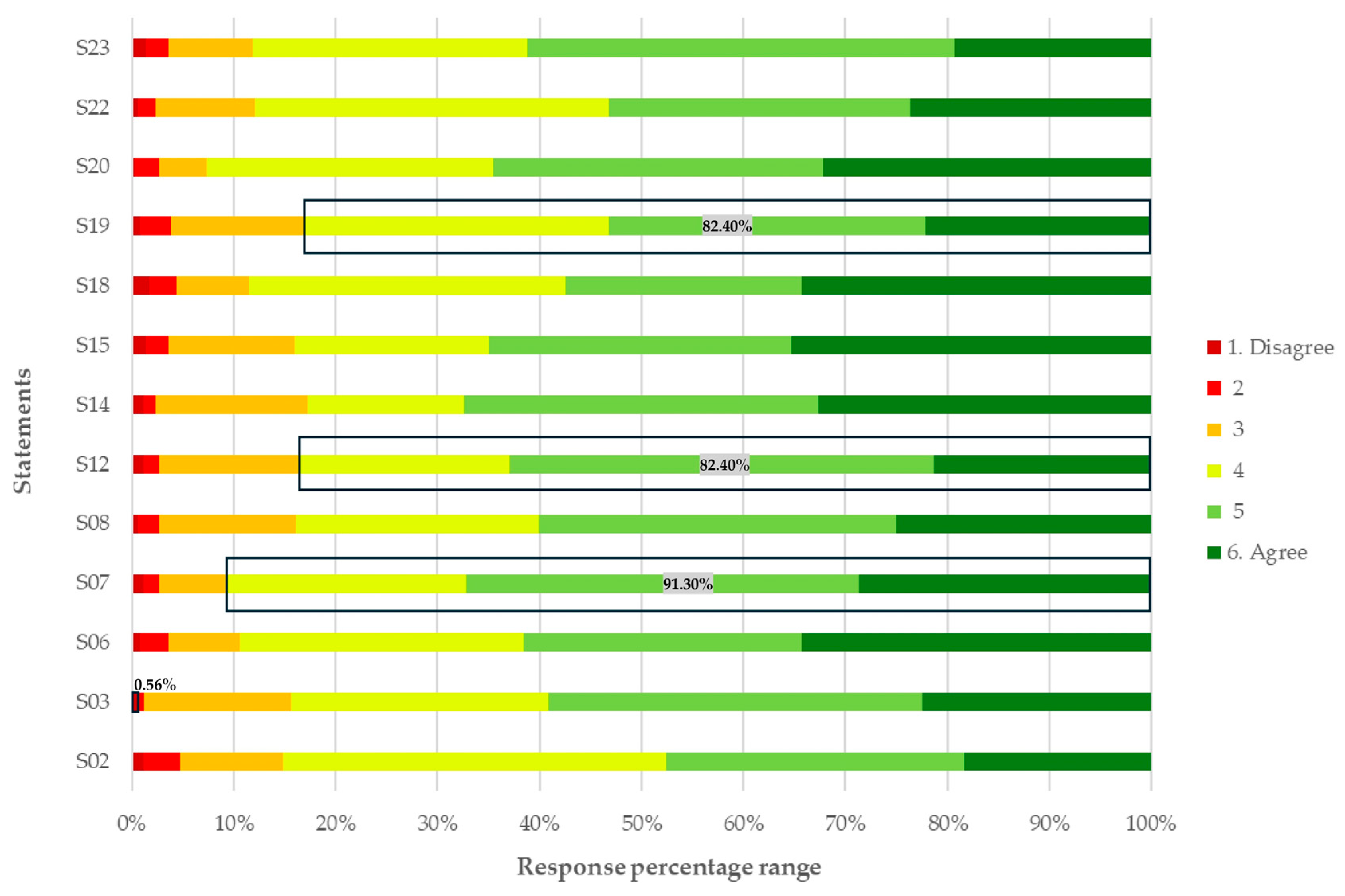Mobile Augmented Reality Games Towards Smart Learning City Environments: Learning About Sustainability
Abstract
1. Introduction
1.1. Gaming for Sustainability Education
1.2. The EduCITY Approach for EDS
2. Materials and Methods
2.1. EduCITY Activities and Participants
2.2. Data Collection
2.3. Data Analysis
3. Results and Discussion
3.1. Participants’ Perception About the Activities’ Contribution to Education for Sustainability
Statements: S01 “… be prone to act in line with values and principles for sustainability.”, S02 “… articulate and negotiate sustainability values, principles and objectives while recognising different viewpoints, while recognizing different points of view.”, S03 “… identify processes or action that avoid or reduce the use of natural resources.”, S04 “… know that damaging and exhausting natural resources can lead to disasters and conflicts (e.g., loss of biodiversity, draughts, mass migration and war).”, S05 “… show empathy with all life forms.”, S06 “… evaluate issues and action based on sustainability values and principles.”, S07 “… be able to acknowledge cultural diversity within planetary limits.”, S08 “… be able to apply equity and justice for current and future generations as criteria for environmental preservation and the use of natural resources.”, S09 “… know about environmental justice, namely considering the interests and capabilities of other species and environmental ecosystems.”, S10 “… know the main views on sustainability: anthropocentrism (human-centric), technocentrism (technological solutions to ecological problems) and ecocentrism (nature-centred), and how they influence assumptions and arguments.”, S11 “… be committed to decreasing material consumption.”, S12 “… be able to bring personal choices and action in line with sustainability values and principles.”, S13 “… be willing to share and clarify views on sustainability values.”, S14 “… be able to find opportunities to spend time in nature and helps to restore it.”, S15 “… be able to see and imagine humans living together and respecting other life forms.”, S16 “… know that values and principles influence action that can damage, does not harm, restores or regenerates the environment.”, S18 “… care about a harmonious relationship existing between nature and humans.”, S19 “… respect, understand, and appreciate various cultures in relation to sustainability, including minority cultures, local and indigenous (from a region) traditions and knowledge systems.”, S20 “… be able to assess and question personal needs to carefully manage resources in the pursuit of longer-term goals and common interests.”, S21 “… be able to assess own impact on nature and consider the protection of nature an essential task for every individual.”, S22 “… know that individuals and communities differ in how and how much they can promote sustainability., S23 “… be able to help build consensus on sustainability in an inclusive manner.”, S24 “… be able to identify and include values of communities, including minorities, in problem framing and decision making on sustainability.”, S24 “… know that people are part of nature and that the divide between human and ecological systems is arbitrary.”, S25 “… be ready to critique and value various cultural contexts depending on their impact on sustainability.”
3.2. Game Logs: Educational Value
4. Conclusions
4.1. Key Findings and Educational Contributions
4.2. Advocating for Smart Learning City Environments in Sustainability Education
4.3. Limitations of the Study and Future Research
Author Contributions
Funding
Data Availability Statement
Acknowledgments
Conflicts of Interest
Abbreviations
| MARGs | Mobile Augmented Reality Games |
| ESD | Education for Sustainable Development |
| AR | Augmented Reality |
| CBE | Cycle of Basic Education |
| KSAs | Knowledge, Skills, and Attitudes |
Appendix A. Brief Description of EduCITY Games



- Visit to the Salt Pans
- EduCITY at University Campus
- Aveiro, City of Art Nouveau and Liberty
- Art Nouveau Path
- Aveiro Walking Tour
References
- Rieckmann, M. Learning to transform the world: Key competencies in ESD. In Issues and Trends in Education for Sustainable Development; Leicht, A., Heiss, J., Byun, W.J., Eds.; UNESCO Publishing: Paris, France, 2018; Chapter 2; p. 276. Available online: https://unesdoc.unesco.org/ark:/48223/pf0000261445 (accessed on 4 June 2025).
- Perrotti, D.; Verma, P.; Srivastava, K.; Singh, P. Challenges and opportunities at the crossroads of Environmental Sustainability and Economy research. In Environmental Sustainability and Economy; Elsevier: Amsterdam, The Netherlands, 2021; pp. 345–360. [Google Scholar] [CrossRef]
- Konrad, T.; Wiek, A.; Barth, M. Embracing conflicts for interpersonal competence development in project-based sustainability courses. Int. J. Sustain. High. Educ. 2020, 21, 76–96. [Google Scholar] [CrossRef]
- Wiek, A.; Withycombe, L.; Redman, C.L. Key competencies in sustainability: A reference framework for academic program development. Sustain. Sci. 2011, 6, 203–218. [Google Scholar] [CrossRef]
- UNESCO. Education for Sustainable Development: A Roadmap—UNESCO Digital Library. 2020. Available online: https://doi.org/10.54675/YFRE1448 (accessed on 28 May 2025).
- Bucea-Manea-Țoniș, R.; Păun, D.G.; Martins, O.M.D.; Santos, A.J.; Urdeș, L. Education for Sustainable Development: What Matters? Sustainability 2024, 16, 9493. [Google Scholar] [CrossRef]
- Huang, Y.-L.; Chang, D.-F.; Wu, B. Mobile Game-Based Learning with a Mobile App: Motivational Effects and Learning Performance. J. Adv. Comput. Intell. Intell. Inform. 2017, 21, 963–970. [Google Scholar] [CrossRef]
- Macagno, T.; Nguyen-Quoc, A.; Jarvis, S.P. Nurturing Sustainability Changemakers through Transformative Learning Using Design Thinking: Evidence from an Exploratory Qualitative Study. Sustainability 2024, 16, 1243. [Google Scholar] [CrossRef]
- Bianchi, G.; Pisiotis, U.; Cabrera, M.; Punie, Y.; Bacigalupo, M. The European Sustainability Competence Framework; Publications Office of the European Union: Luxembourg, 2022. [Google Scholar] [CrossRef]
- Mettis, K.; Väljataga, T. Designing learning experiences for outdoor hybrid learning spaces. Br. J. Educ. Technol. 2021, 52, 498–513. [Google Scholar] [CrossRef]
- Mercan, G.; Selçuk, Z.V. Enhancing Environmental Education Through Location-Based Games (LBGs) in Biology Education. J. Soc. Sci. Educ. 2024, 7, 140–169. [Google Scholar] [CrossRef]
- Tan, C.K.W.; Nurul-Asna, H. Serious games for environmental education. Integr. Conserv. 2023, 2, 19–42. [Google Scholar] [CrossRef]
- Cosio, L.D.; Buruk, O.O.; Galeote, D.F.; Bosman, I.D.V.; Hamari, J. Virtual and Augmented Reality for Environmental Sustainability: A Systematic Review. In Proceedings of the 2023 CHI Conference on Human Factors in Computing Systems, Hamburg, Germany, 23–28 April 2023; 28 April 2023. [Google Scholar] [CrossRef]
- Laine, T.H. Mobile Educational Augmented Reality Games: A Systematic Literature Review and Two Case Studies. Computers 2018, 7, 19. [Google Scholar] [CrossRef]
- Santos, B.S.; Dias, P.; Madeira, J. A Virtual and Augmented Reality Course Based on Inexpensive Interaction Devices and Displays. In EuroGraphics 2015—Education Papers; The Eurographics Association: Eindhoven, The Netherlands, 2015. [Google Scholar] [CrossRef]
- Akçayır, M.; Akçayır, G. Advantages and challenges associated with augmented reality for education: A systematic review of the literature. Educ. Res. Rev. 2017, 20, 1–11. [Google Scholar] [CrossRef]
- Bressler, D.M.; Oltman, J.; Vallera, F.L. Inside, Outside, and Off-Site: Social Constructivism in Mobile Games. In Handbook of Research on Mobile Technology, Constructivism, and Meaningful Learning; Keengwe, J., Ed.; IGI Global Scientific Publishing: Hershey, PA, USA, 2018; pp. 1–22. [Google Scholar] [CrossRef]
- Chen, S.Y. To explore the impact of augmented reality digital picture books in environmental education courses on environmental attitudes and environmental behaviors of children from different cultures. Front. Psychol. 2022, 13, 1063659. [Google Scholar] [CrossRef] [PubMed]
- Irabor, T.-J.; Yameogo, P.S.A.; Perrin, L.; Pétré, B.; Faulx, D.; Ruëgg, S.R.; Antoine-Moussiaux, N. Gaming for change—Exploring systems thinking and sustainable practices through complexity-inspired game mechanics. Humanit. Soc. Sci. Commun. 2025, 12, 680. [Google Scholar] [CrossRef]
- Lampropoulos, G.; Keramopoulos, E.; Diamantaras, K.; Evangelidis, G. Integrating Augmented Reality, Gamification, and Serious Games in Computer Science Education. Educ. Sci. 2023, 13, 618. [Google Scholar] [CrossRef]
- Beça, P.; Amado, P.; Antunes, M.J.; Matos, M.; Ferreira, E.; Alves, A.; Couto, A.; Marques, R.; Pinho, R.; Lopes, L.; et al. From technological specifications to beta version: The development of the imprint+ web app. In Smart Innovation, Systems and Technologies; Springer Science and Business Media Deutschland GmbH: Berlin/Heidelberg, Germany, 2018; Volume 80, pp. 179–188. [Google Scholar] [CrossRef]
- Zydney, J.M.; Warner, Z. Mobile apps for science learning: Review of research. Comput. Educ. 2016, 94, 1–17. [Google Scholar] [CrossRef]
- Strada, F.; Lopez, M.X.; Fabricatore, C.; dos Santos, A.D.; Gyaurov, D.; Battegazzorre, E.; Bottino, A. Leveraging a collaborative augmented reality serious game to promote sustainability awareness, commitment and adaptive problem-management. Int. J. Human-Comput. Stud. 2023, 172, 102984. [Google Scholar] [CrossRef]
- Toma, R.B.; Yánez-Pérez, I.; Meneses-Villagrá, J.Á. Towards a Socio-Constructivist Didactic Model for Integrated STEM Education. Interchange 2024, 55, 75–91. [Google Scholar] [CrossRef]
- Pombo, L.; Marques, M.M. EduCITY as a smart learning city environment towards education for sustainability—Work in progress. In Proceedings of EdMedia + Innovate Learning; Bastiaens, T., Ed.; AACE: Vienna, Austria, 2023; pp. 133–139. Available online: https://www.learntechlib.org/primary/p/222493/ (accessed on 4 June 2025).
- Pombo, L.; Marques, M.M. An App that Changes Mentalities about Mobile Learning—The EduPARK Augmented Reality Activity. Computers 2019, 8, 37. [Google Scholar] [CrossRef]
- Schoonenboom, J.; Johnson, R.B. How to Construct a Mixed Methods Research Design. Koln. Z. Fur Soziol. Und Sozialpsychol. 2017, 69, 107–113. [Google Scholar] [CrossRef]
- Redman, A.; Wiek, A. Competencies for Advancing Transformations Towards Sustainability. Front. Educ. 2021, 6, 785163. [Google Scholar] [CrossRef]
- Ferreira-Santos, J.; Marques, M.M.; Pombo, L. GreenComp-Based Questionnaire (GCQuest): Questionnaire Development and Validation. Preprints 2024. [Google Scholar] [CrossRef]
- Braun, V.; Clarke, V. Using thematic analysis in psychology. Qual. Res. Psychol. 2006, 3, 77–101. [Google Scholar] [CrossRef]
- Creswell, J.W.; Creswell, J.D. Research Design: Qualitative, Quantitative, and Mixed Methods Approaches, 5th ed.; SAGE: Los Angeles, CA, USA, 2018; Available online: https://spada.uns.ac.id/pluginfile.php/510378/mod_resource/content/1/creswell.pdf (accessed on 28 May 2025).
- Hair, J.F.; Hult, G.T.M.; Ringle, C.M.; Sarstedt, M.; Danks, N.P.; Ray, S. An Introduction to Structural Equation Modeling. In Partial Least Squares Structural Equation Modeling (PLS-SEM) Using R; Hair, J.F., Hult, G.T.M., Ringle, C.M., Sarstedt, M., Danks, N.P., Ray, S., Eds.; Springer: Cham, Switzerland, 2021; Chapter 1; pp. 1–29. [Google Scholar] [CrossRef]
- Groves, R.M.; Fowler, F.J., Jr.; Couper, M.P.; Lepkowski, J.M.; Singer, E.; Tourangeau, R. Survey Methodology, 2nd ed.; John Wiley & Sons: Hoboken, NJ, USA, 2009; Available online: https://download.e-bookshelf.de/download/0000/8065/21/L-G-0000806521-0002312179.pdf (accessed on 28 May 2025).
- MacQueen, K.M.; Guest, G. An introduction to team-based qualitative research. In Handbook for Team-Based Qualitative Research; Rowman Altamira: Lanham, MD, USA, 2008; pp. 3–19. [Google Scholar]
- Sousa, B.; Ferreira-Santos, J.; Marques, M.M.; Pombo, L. GreenComp-based Questionnaire (GCQuest) analysis tool: A practical guide for educators and researchers. Zenodo 2025. [Google Scholar] [CrossRef]
- Cobern, W.W.; Adams, B. Establishing survey validity: A practical guide. Int. J. Assess. Tools Educ. 2020, 7, 404–419. [Google Scholar] [CrossRef]
- Baumber, A. Transforming sustainability education through transdisciplinary practice. Environ. Dev. Sustain. 2022, 24, 7622–7639. [Google Scholar] [CrossRef]
- Alkaher, I.; Goldman, D.; Sagy, G. Culturally Based Education for Sustainability—Insights from a Pioneering Ultraorthodox City in Israel. Sustainability 2018, 10, 3721. [Google Scholar] [CrossRef]
- Oliveira, R.P.; de Souza, C.G.; Reis, A.d.C.; de Souza, W.M. Gamification in E-Learning and Sustainability: A Theoretical Framework. Sustainability 2021, 13, 11945. [Google Scholar] [CrossRef]
- Sweller, J.; Ayres, P.; Kalyuga, S. Cognitive Load Theory; Springer: New York, NY, USA, 2011. [Google Scholar] [CrossRef]
- Brown, T.H.; Mbati, L.S. Mobile learning: Moving past the myths and embracing the opportunities. Int. Rev. Res. Open Distrib. Learn. 2015, 16, 115–135. [Google Scholar] [CrossRef]




| Name of the Games | Number of Activities | Number of Players | ||||
|---|---|---|---|---|---|---|
| 2nd/3rd CBE | Secondary Education | Higher Education | Teacher Training | Total | ||
| Visit to the Salt Pans | 1 | 30 | - | - | - | 30 |
| EduCITY at the University Campus | 2 | - | 27 | 46 | 19 | 92 |
| Aveiro, City of Art Nouveau and Liberty | 1 | 20 | - | - | - | 20 |
| Art Nouveau Path | 9 | 118 | 49 | 25 | - | 192 |
| Aveiro Walking Tour | 1 | - | - | - | 40 | 40 |
| Total | 15 | 168 | 76 | 71 | 59 | 374 |
| Theme | Subtheme | Descriptor | Citation (Translated Sentence) | N | Rel. Freq (%) |
|---|---|---|---|---|---|
| Cultural Awareness | Local culture | Engagement with local identity, traditions, and heritage | ‘[Learn about the Arte Nova Museum and the José Estêvão Monument]’ | 304 | 59.49 |
| Environmental Protection | Waste management (e.g., microplastics, food waste) | Consequence awareness and actions related to reducing, reusing, and recycling waste | ‘[Food waste at the University]’ | 29 | 5.68 |
| Natural resources management (e.g., water, soil, stone and wood as building materials) | Responsible use and understanding of ecological materials | ‘[Examples of Art Nouveau buildings; sand/adobe constructions; materials used]’ | 20 | 3.91 | |
| Biodiversity preservation | Appreciation and care for ecosystems and species diversity | ‘[Preserving the environment and animals; What is salt and salt pans; Microplastics]’ | 17 | 3.33 | |
| Environment/ nature | General concern and connection to the natural world | ‘[soil composition, statue materials, carder materials]’ | 9 | 1.76 | |
| Local natural resources (e.g., salt) | Knowledge of region-specific environmental assets | ‘[Curiosities about salt and microplastics]’ | 4 | 0.78 |
| Theme | Subtheme | Descriptor (Based on GreenComp Framework) | Citation (Translated Sentence) | N | Rel. Freq (%) |
|---|---|---|---|---|---|
| Values and behaviors | Responsible use of resources | To acknowledge that humans are part of Nature; and to respect the needs and rights of other species and of Nature itself to restore and regenerate healthy and resilient ecosystems | ‘[Don’t spend all resources in the present’] | 93 | 23.79 |
| Sustainable lifestyle | To support equity and justice for current and future generations and learn from previous generations for sustainability | ‘[Sustainability is essential if we are to continue living on our planet.’] | 24 | 6.14 | |
| Sustainable values | To reflect on personal values; identify and explain how values vary among people and over time, while critically evaluating how they align with sustainability values | ‘[the formation of aware and committed citizens for a balanced future’] | 9 | 2.30 | |
| Present actions | Environmental preservation | To identify own potential for sustainability and to actively contribute to improving prospects for the community and the planet | ‘[It’s about being responsible towards nature and the animals around us. In this way we can have a more cared and healthier planet to live on.’] | 91 | 23.27 |
| Future thinking | Intergenerational equity | To envision alternative sustainable futures by imagining and developing alternative scenarios and identifying the steps needed to achieve a preferred sustainable future | To manage transitions and challenges in complex sustainability situations and make decisions related to the future in the face of uncertainty, ambiguity and risk | ‘[thinking about the future of the planet’] | 85 | 21.74 |
| (Unspecified information or not related to sustainability) | 89 | 22.76 | |||
| Games | ||||||
|---|---|---|---|---|---|---|
| Visit to the Salt Pans | EduCITY on University Campus | Aveiro, City of Art Nouveau and Liberty | Art Nouveau Path: From Heritage to Sustainability | Aveiro Walking Tour | ||
| Number of groups who played the game | 7 | 39 | 5 | 59 | 14 | |
| Final score | Average | 64.29% | 76.70% | 86.40% | 83.30% | 66.30% |
| Standard deviation | 5.34 | 10.33 | 5.35 | 29.77 | 19.83 | |
| Minimum-maximum | 50.00% - 71.40% | 35.00% - 100.00% | 75.30% - 90.90% | 33.33% - 100.00% | 29.20% - 95.00% | |
| AR score | Average | 56.25% | 86.84% | 81.81% | 75.00% | 81.80% |
| Standard deviation | 3.20 | 21.95 | 19.00 | 40.16 | 3.16 | |
| Minimum-maximum | 0.00% - 100.00 | 4.17% - 100.00% | 83.33% - 100.00% | 27.27% - 100.00% | 57.14% - 100.00% | |
| Correct answers | Average | 64.30% | 80.58% | 85.40% | 86.11% | 72.40% |
| Standard deviation | 1.07 | 18.89 | 1.07 | 4.96 | 3.26 | |
| Minimum-maximum | 50,00% - 71.40% | 45.83% - 100.00% | 77.30% - 90.90% | 44.44% - 100.00% | 41.20% - 95.90% | |
| Incorrect answers | Average | 35.70% | 19.42% | 13.60% | 13.89% | 30.30% |
| Standard deviation | 1.07 | 5.11 | 1.07 | 4.96 | 3.55 | |
| Minimum-maximum | 28.60% - 50.00% | 0.00% - 54.17% | 9.10% - 22.70% | 0.00% - 55.56% | 4.20% - 62.50% | |
Disclaimer/Publisher’s Note: The statements, opinions and data contained in all publications are solely those of the individual author(s) and contributor(s) and not of MDPI and/or the editor(s). MDPI and/or the editor(s) disclaim responsibility for any injury to people or property resulting from any ideas, methods, instructions or products referred to in the content. |
© 2025 by the authors. Licensee MDPI, Basel, Switzerland. This article is an open access article distributed under the terms and conditions of the Creative Commons Attribution (CC BY) license (https://creativecommons.org/licenses/by/4.0/).
Share and Cite
Marques, M.M.; Ferreira-Santos, J.; Rodrigues, R.; Pombo, L. Mobile Augmented Reality Games Towards Smart Learning City Environments: Learning About Sustainability. Computers 2025, 14, 267. https://doi.org/10.3390/computers14070267
Marques MM, Ferreira-Santos J, Rodrigues R, Pombo L. Mobile Augmented Reality Games Towards Smart Learning City Environments: Learning About Sustainability. Computers. 2025; 14(7):267. https://doi.org/10.3390/computers14070267
Chicago/Turabian StyleMarques, Margarida M., João Ferreira-Santos, Rita Rodrigues, and Lúcia Pombo. 2025. "Mobile Augmented Reality Games Towards Smart Learning City Environments: Learning About Sustainability" Computers 14, no. 7: 267. https://doi.org/10.3390/computers14070267
APA StyleMarques, M. M., Ferreira-Santos, J., Rodrigues, R., & Pombo, L. (2025). Mobile Augmented Reality Games Towards Smart Learning City Environments: Learning About Sustainability. Computers, 14(7), 267. https://doi.org/10.3390/computers14070267







